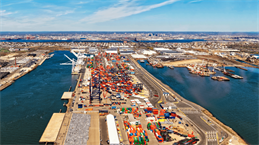
The potential strike at ports along the US East Coast and Gulf in October is anticipated to further disrupt supply chains.
Container shipping consultancy firm Xeneta has cautioned European shippers to take preemptive action to prevent any disruption to their supply chains due to potential strikes by dockworkers on the US East Coast.
The International Longshoremen's Association (ILA) has previously warned that its 85,000 members will go on strike on October 1 if a new contract is not agreed upon before that date. The ILA's current pay deal expires on September 30.
"Less than seven weeks remain to agree on a new pay deal and avert union strike action at US East and Gulf Coast ports – meaning time is now up for shippers to take decisive action to protect supply chains," Peter Sand, chief analyst at Xeneta said in a new analysis.
"With a port-to-port sailing time of 24 days on a typical Transatlantic trade from Genoa to Savannah, plus around 10 days [of] land operations at either end, shippers must act now if they wish to utilize alternative supply chain options," he added.
Sand noted that if European exporters carry on regardless and continue loading containers onto ships scheduled to arrive at the US East and Gulf Coast after September 30, they will be at the mercy of union negotiations and the possibility of their cargo becoming snarled in severe port congestion.
Meanwhile, he pointed out that "the window of opportunity has already passed for shippers on the major fronthaul trades from the Far East to US East and Gulf coasts."
"With port-to-port sailing times of 50 days between Shanghai and New York, plus land operations, there are already containers on the ocean which will arrive on the US East Coast after September 30 – deal or no deal," Xeneta's chief analyst said of the Transpacific shippers.
Sand said shippers are now left with "very few options."
"The best solution may have already been and gone."
The Xenea chief analyst added that container volumes from South East Asia to North America hit an all-time high in June at 500,000 TEUs, signalling the early arrival of the traditional peak season. Accumulated volumes for the first half of 2024 are up 23% compared to the first half of last year.
"No doubt this was largely driven by ongoing concerns over the impact of conflict in the Red Sea and a potential capacity crunch later in the year. But shippers will have also factored in the threat of strike action on the US East and Gulf Coast," Sand said.
"Therefore, it seems shippers' preferred option to protect supply chains in 2024 has been to build up inventories by importing goods as quickly as possible. Should the worst happen, at least they have built a buffer into their supply chain," he added.
If shippers are looking for alternatives at the moment, Sand said they could consider importing into Montreal—though there are additional complexities involved. Halifax is also an option, but this port could not cope with the volume of US East Coast trades.
"Mexico East Coast ports are a viable alternative, but re-aligning supply chains to this extent in such a short period of time is fraught with difficulty," he said.
Sea-Intelligence estimated that the ports on the US East Coast would handle 2.3 million TEUs in October. In the event of a dockworker strike, this would equate to an impact of 74,000 TEUs per day.



